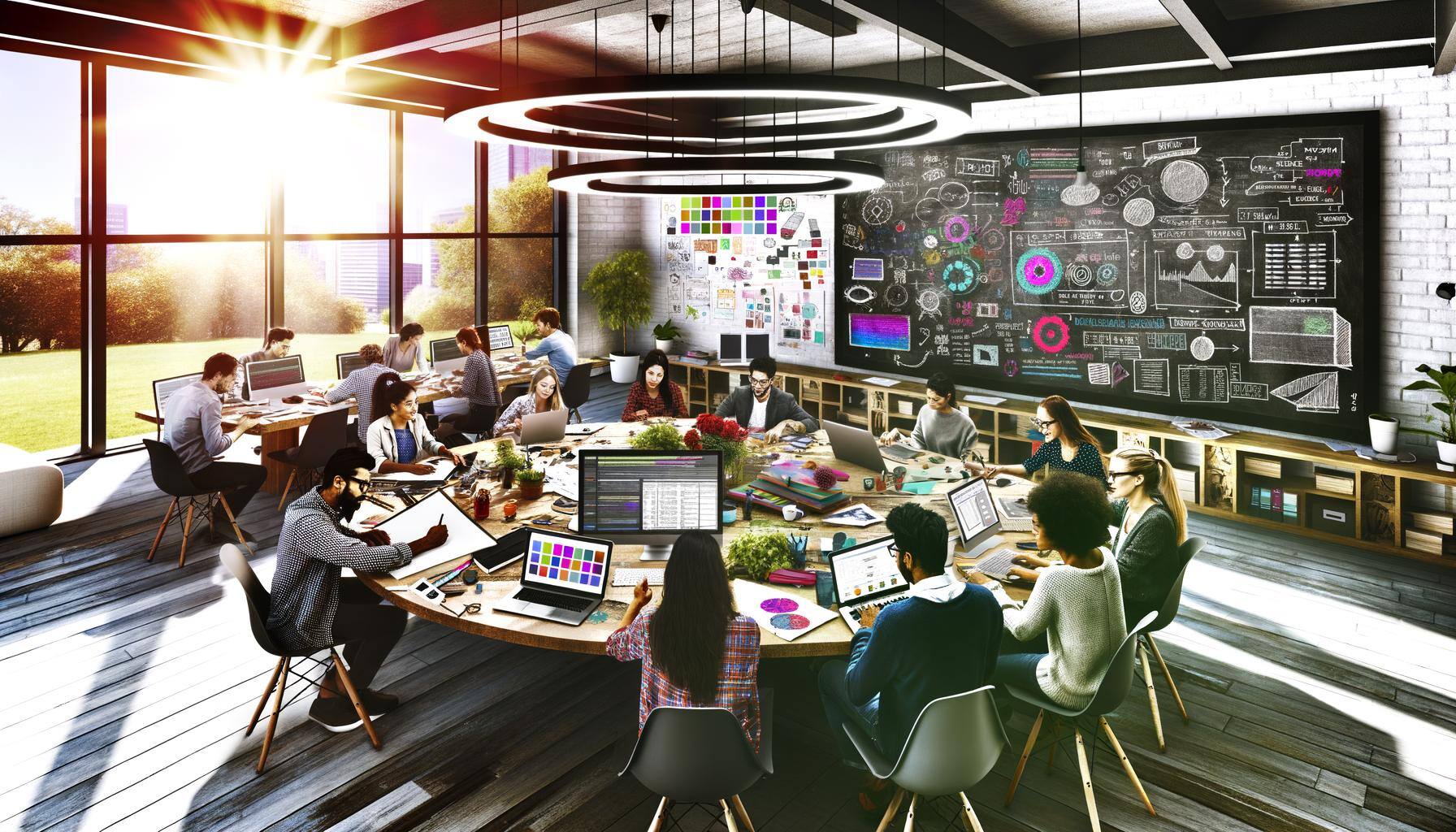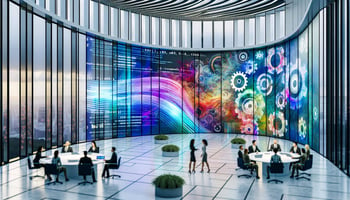Reimagining IT Architecture Through Artistic Lenses In the rapidly evolving world of technology, IT...
Artistic Expression in IT: A New Era of Innovation

Blurring the Lines Between Art and IT
In today's dynamic technological landscape, the boundaries between art and IT are becoming increasingly indistinct. This convergence is redefining how businesses approach IT architecture, transforming it from a mere technical discipline into a realm of creative expression. This shift provides organizations with a unique opportunity to embrace IT not just as a tool for efficiency but as a canvas for innovation and artistic exploration.
The infusion of artistic principles into IT architecture encourages a departure from conventional methods. It opens the door to imagination and experimentation, leading to solutions that are both functional and aesthetically appealing. By viewing IT through an artistic lens, businesses can foster a culture of creativity that drives innovation and enhances their competitive edge. This approach not only improves system design but also enriches the user experience, making technology more engaging and intuitive.
The Role of Creativity in IT Architecture
Creativity is at the heart of transforming IT architecture into an art form. It involves reimagining traditional processes and embracing new perspectives to solve complex challenges. By adopting an artistic mindset, IT professionals can develop innovative solutions that break free from the constraints of conventional design.
This creative approach encourages IT architects to think outside the box, leading to the development of systems that are not only efficient but also resonate on an emotional and intellectual level. By incorporating elements of design, such as symmetry, balance, and contrast, IT solutions can become more intuitive and user-friendly. This artistic vision fosters a deeper connection between users and technology, enhancing satisfaction and productivity.
Moreover, creativity in IT architecture promotes adaptability and resilience. In a world where technology is constantly evolving, the ability to innovate and respond to change is crucial. By leveraging artistic principles, businesses can create agile IT infrastructures that can quickly adapt to new challenges and opportunities, ensuring long-term success.
Harnessing Synergy: Art and Technology Intersect
The intersection of art and technology is a powerful catalyst for innovation. Both disciplines share a symbiotic relationship, where each influences and enhances the other. In the realm of IT, this synergy can be harnessed to create systems that are not only efficient but also emotionally engaging.
Artistic expression in technology is evident in the design of user interfaces, where elements of color theory, composition, and visual storytelling are used to enhance usability and engagement. By integrating artistic elements into technology, businesses can create more intuitive and engaging user experiences. This approach not only improves user satisfaction but also enhances the overall effectiveness of the technology.
The synergy between art and technology extends beyond aesthetics. It encourages a holistic approach to problem-solving, where technical challenges are met with creative solutions. By embracing this synergy, businesses can foster a culture of innovation that drives success and growth.
Designing User-Centric Systems with Artistic Flair
Designing systems with an artistic flair involves more than just aesthetics; it is about creating user-centric solutions that inspire and empower. By leveraging artistic principles, IT architects can design systems that are intuitive, adaptable, and user-focused.
One way to incorporate artistic expression into system design is through the use of metaphor and narrative. By viewing a system as a story, designers can create a more cohesive and engaging experience for users. This narrative approach helps users understand and navigate complex systems by providing context and meaning to their interactions.
Additionally, artistic expression in system design fosters adaptability and flexibility. By designing systems that can evolve and respond to changing needs, businesses can enhance their agility and competitiveness. This approach encourages experimentation and innovation, leading to the development of more effective and efficient systems.
Case Studies: Success Stories of Art-Inspired IT
Several companies have successfully integrated artistic principles into their IT strategies, achieving remarkable results. For example, a boutique IT consultancy firm re-imagined their system architecture as a dynamic, ever-evolving artwork. By doing so, they were able to create a more agile and responsive IT infrastructure, resulting in increased efficiency and reduced costs.
Another example is a global technology company that used principles of minimalist art to streamline their user interface design. By focusing on simplicity and clarity, they were able to enhance user satisfaction and reduce training costs. This approach not only improved the user experience but also increased the overall efficiency of their systems.
These case studies demonstrate the power of art-inspired IT solutions to drive business success. By embracing artistic principles, organizations can create systems that are not only functional but also innovative and inspiring.
Maximizing Agility Through Creative IT Strategies
In today's fast-paced business environment, agility is key to success. By adopting creative IT strategies, businesses can enhance their agility and responsiveness, enabling them to seize new opportunities and navigate challenges with ease. Artistic expression in IT can play a crucial role in fostering this agility.
Creative IT strategies involve rethinking traditional approaches to system design and implementation. By embracing an artistic mindset, organizations can develop more flexible and adaptable IT solutions that can quickly respond to changing needs and opportunities. This approach encourages experimentation and innovation, leading to the development of more effective and efficient systems.
By integrating artistic principles into their IT strategies, businesses can create a more agile and responsive IT infrastructure, enabling them to thrive in an increasingly competitive and dynamic market.
Leveraging Innovative Tools for Artistic IT Execution
Innovative tools play a crucial role in executing artistic IT strategies. Advanced technologies, such as artificial intelligence and machine learning, can be leveraged to create more sophisticated and responsive systems. These tools enable IT professionals to experiment with new ideas and approaches, leading to the development of more innovative and effective solutions.
For example, AI-powered design tools can help IT architects explore new design possibilities and create more intuitive and engaging user interfaces. Machine learning algorithms can be used to optimize system performance and enhance user experience, resulting in more efficient and effective IT solutions.
By embracing innovative tools, businesses can unlock new possibilities for artistic expression in IT, leading to the development of more creative and effective systems.
Future Trends: The Evolution of IT as an Art Form
As technology continues to evolve, so too does the role of art in IT. In the future, we can expect to see even greater integration of artistic principles into IT strategies, leading to the development of more innovative and effective solutions.
One emerging trend is the use of virtual and augmented reality to create immersive and engaging user experiences. These technologies offer new possibilities for artistic expression in IT, enabling businesses to create more dynamic and interactive systems.
Another trend is the increasing use of data visualization to communicate complex information in a more intuitive and accessible way. By leveraging the principles of art and design, businesses can create more effective data visualizations that enhance understanding and decision-making.
As IT continues to evolve as an art form, businesses that embrace artistic principles will be better equipped to navigate the challenges and opportunities of the future. By fostering a culture of creativity and innovation, organizations can develop more effective and inspiring IT solutions that drive business success.



